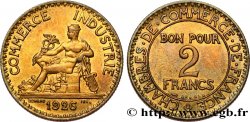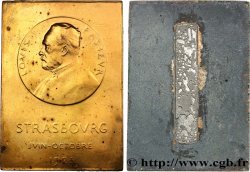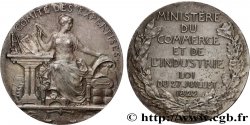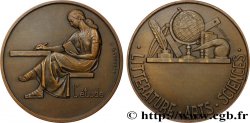fme_369607 - III REPUBLIC Plaquette de concours musical
Not available.
Item sold on our e-shop (2018)
Price : 140.00 €
Item sold on our e-shop (2018)
Price : 140.00 €
Type : Plaquette de concours musical
Date: 1914
Mint name / Town : 76 - Le Havre
Metal : bronze
Diameter : 52 mm
Orientation dies : 12 h.
Engraver RASUMNY Félix (1869-1940)
Weight : 81 g.
Edge : lisse + carré BRONZE
Coments on the condition:
Jolie plaquette en bel état avec une patine brune
Obverse
Obverse legend : CINQUANTENAIRE DE LA LYRE HAVRAISE // 1864 - 1914.
Obverse description : Allégorie féminine volant, une trompe dans la main gauche.
Reverse
Reverse legend : VILLE DU HAVRE / CONCOURS MUSICAL / 31 MAI - 1ER JUIN / 1914.
Reverse description : Légende en quatre lignes dans un cartouche à côté d’une branche de lauriers, de chêne et une palme liées ensemble.
Commentary
Plaquette du cinquantenaire de la Lyre Havraise, foncée le 24 octobre 1864 par Auguste Blavet, typographe et compositeur autodidacte. C’était un groupement d’homme, d’où ces noms d’orphéons et de société orphéonique. La Lyre Havraise allait connaître une renommée nationale et même internationale, et exister jusqu’en 1979. Outre cette belle réputation, elle était appréciée également en tant que “véritable foyer d’éducation et de vulgarisation de la musique et du chant “ (Georges Dumouchel, dans un exposé sur l’histoire de la Lyre Havraise présenté aux Amis du Vieux Havre en 1977).
De 1868 à 1914, la Lyre Havraise “connaît une carrière exceptionnelle ponctuée de 122 prix et de 294 concerts à travers la France. En 1897, elle était reçue à l’Élysée par un certain Félix Faure, cet homme qui avait accepté en 1880 d’en être le président d’honneur et interprétait quelques oeuvres de cette époque.
Félix Rasumny, né le 20 avril 1869 à Sébastopol, et mort à Paris en 1940, est un sculpteur, médailleur et bijoutier russe naturalisé français.
Représentant de l'Art nouveau, il est l'élève d'Aimé Millet, Camille Gauthier et Paulin Tasset. Sociétaire des artistes français depuis 1907, il figure au Salon de ce groupement depuis 1889. Il devient membre de la Société nationale des beaux-arts en 1911. Félix Rasumny obtient une mention honorable en 1891, et une médaille d'argent à l'Exposition universelle de 1911. Il est nommé chevalier de la Légion d'honneur en 1933..
De 1868 à 1914, la Lyre Havraise “connaît une carrière exceptionnelle ponctuée de 122 prix et de 294 concerts à travers la France. En 1897, elle était reçue à l’Élysée par un certain Félix Faure, cet homme qui avait accepté en 1880 d’en être le président d’honneur et interprétait quelques oeuvres de cette époque.
Félix Rasumny, né le 20 avril 1869 à Sébastopol, et mort à Paris en 1940, est un sculpteur, médailleur et bijoutier russe naturalisé français.
Représentant de l'Art nouveau, il est l'élève d'Aimé Millet, Camille Gauthier et Paulin Tasset. Sociétaire des artistes français depuis 1907, il figure au Salon de ce groupement depuis 1889. Il devient membre de la Société nationale des beaux-arts en 1911. Félix Rasumny obtient une mention honorable en 1891, et une médaille d'argent à l'Exposition universelle de 1911. Il est nommé chevalier de la Légion d'honneur en 1933..








 Report a mistake
Report a mistake Print the page
Print the page Share my selection
Share my selection Ask a question
Ask a question Consign / sell
Consign / sell
 Full data
Full data



